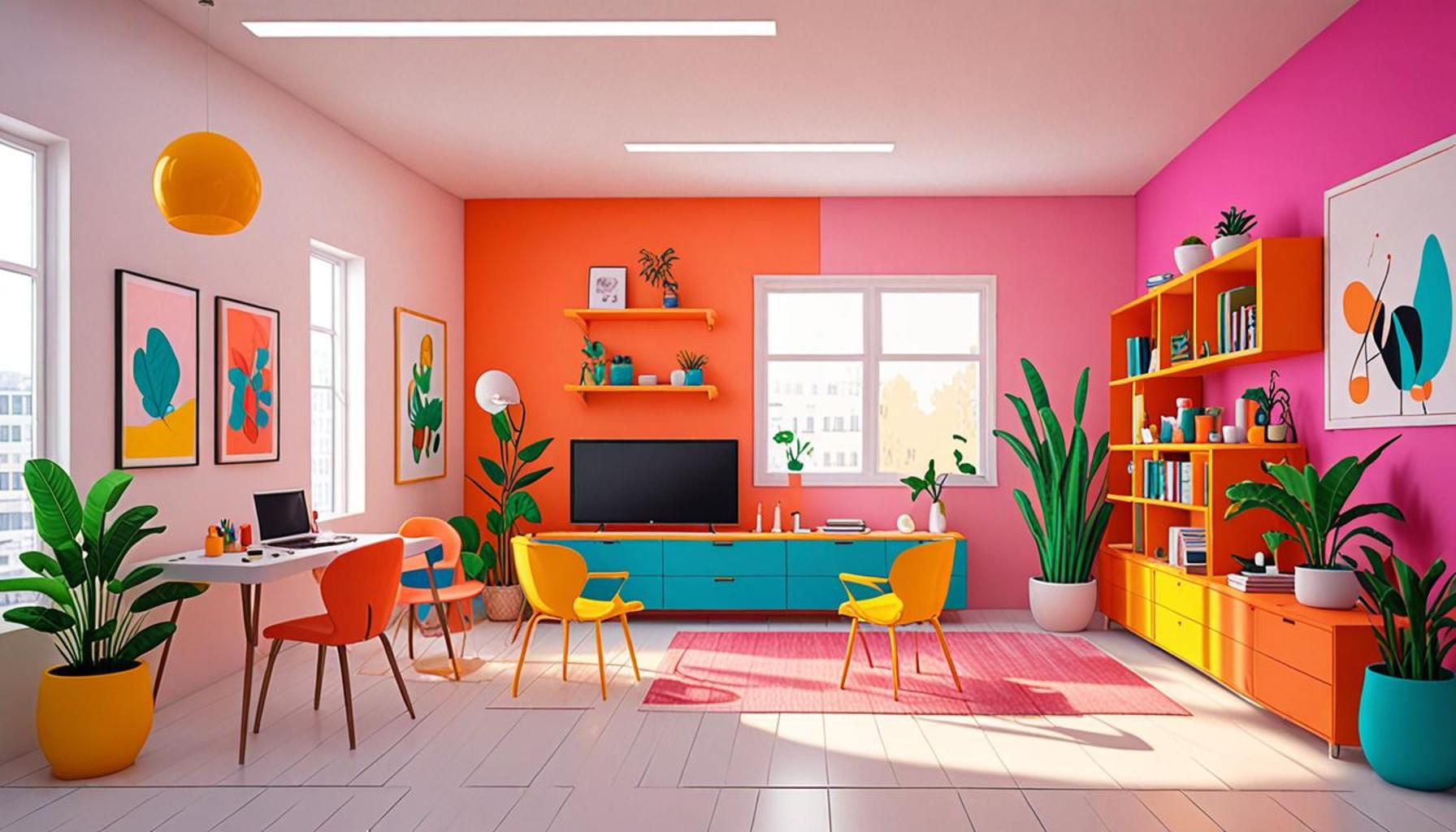The Impact of Natural Light on Space Organization: Creating Open and Cozy Environments

Understanding the Role of Natural Light
Natural light serves as an essential element in our environments, influencing not just the aesthetic aspects but also our psychological state. With its ability to shift moods and create a sense of wellbeing, integrating natural light into design is akin to weaving a vibrant thread into the fabric of a space. The interplay between sunlight and architecture can lead to happier, healthier living and working environments that feel inviting and less constricted.
Key Benefits of Natural Light in Space Organization
Embracing natural light can bring numerous advantages to any setting. Below are some of the key benefits that exemplify how light impacts both organization and comfort:
- Promotes Productivity: Numerous studies demonstrate that exposure to natural light can significantly enhance productivity levels in the workplace. For instance, offices with large windows that allow ample sunlight can lead to improved focus and efficiency, as employees often feel more energized and engaged. Companies like Google have incorporated this concept with open office designs and vast glass windows, fostering a workspace that encourages creativity and collaboration.
- Enhances Mood: Sunlight can uplift spirits, creating a positive atmosphere that breeds tranquility. Studies have shown that natural light influences the production of serotonin, a hormone that contributes to happiness. Spaces flooded with sunlight, such as cozy reading nooks or open-plan living areas, can evoke a sense of calm and contentment, making occupants feel more at ease.
- Visual Expansion: One of the remarkable aspects of natural light is its ability to create the illusion of space. Rooms bathed in sunlight not only feel larger but can also help diminish feelings of confinement that are often present in poorly lit environments. By utilizing large windows or open layouts, homeowners can cultivate a sense of freedom and spaciousness that invites both comfort and creativity.
Embracing Open and Cozy Environments
In pursuing a balanced living or working space, leveraging the power of natural light is crucial. Architectural innovations, such as strategically placed skylights or expansive glass doors that blur the lines between indoors and outdoors, enhance this experience. For example, many modern homes in regions like California are designed with open plans and large windows that invite the beauty of the climate inside, fostering a seamless connection with nature.
As you explore ways to bring the outdoors in, remember that a well-organized space extends beyond merely the arrangement of physical items. It’s about cultivating an atmosphere enriched by light—a space where occupants can thrive. This comprehensive approach not only transforms physical environments but also nurtures our mental and emotional well-being, making natural light an invaluable resource in our daily lives.
DISCOVER MORE: Click here to learn how minimalism can enhance your home office

Maximizing Natural Light in Interior Design
When it comes to space organization, maximizing the flow of natural light is not just about aesthetics; it is an essential aspect of functional design. Natural light can transform how we perceive and use our spaces, enhancing comfort and promoting well-being. Furthermore, understanding how to strategically position elements within a room can lead to an optimized environment that welcomes light and makes it an integral part of the living experience.
To effectively harness the power of natural light, several key elements should be considered:
- Window Placement: The positioning of windows can dramatically affect how light enters a space. For example, windows should be placed to capture sunlight at different times of the day, especially in areas where activities are concentrated, such as living rooms or home offices. East-facing windows allow for bright, warm mornings, while west-facing windows capture dramatic sunsets, enriching the ambiance.
- Color Choices: The colors of walls and furnishings can also influence how light behaves in a room. Light, neutral colors tend to reflect more sunlight compared to darker shades, making spaces feel airier and brighter. Choosing a palette that embraces light not only enhances visual appeal but also cultivates a sense of openness.
- Furniture Arrangement: The layout of furniture should promote unobstructed light pathways throughout the space. By avoiding bulky, heavy furniture pieces that block windows and sunlight, rooms can remain open and cozy. For instance, using low-profile furniture in strategic areas can create intimacy without sacrificing light flow, helping to maintain an airy atmosphere.
As natural light dances through a room, it reveals features that might otherwise go unnoticed. Natural light not only highlights textures and colors but creates dynamic shadows that shift throughout the day, making a space feel alive. This changing interaction can transform mundane areas into sensational experiences. Consider, for example, how the sun filtering through trees can create playful patterns across the floor or walls, crafting a feeling of connection to nature.
In contemporary design, elements such as glass walls, sliding doors, and open floor plans have gained popularity, not only for their aesthetic value but also for their ability to connect interior spaces with the outdoors. These innovative concepts create a harmonious living environment where inhabitants can experience nature, even from the comfort of their homes. As urban dwellers increasingly seek refuge from crowded city life, spaces that embrace these natural elements tend to have a relaxing effect on occupants, encouraging both productivity and leisure.
Enabling an intentional dialogue between light and space can significantly influence our environments, thus creating places where we desire to reside and work. By integrating natural light thoughtfully into space organization, individuals are likely to experience not just visual benefits, but also a profound enhancement in mental clarity and emotional health.
The Impact of Natural Light on Space Organization: Creating Open and Cozy Environments
Natural light plays a critical role in shaping the atmosphere and functionality of any space. As we explore its impact on interior environments, it becomes evident that the integration of natural light not only enhances aesthetic appeal but also promotes mental well-being and productivity. When the sun’s rays stream through windows, they create an inviting ambiance that can transform overcrowded and dull spaces into open and airy environments. This influx of daylight can alter the perception of size and space, making small rooms appear larger and more expansive. The *strategic placement of mirrors* and reflective surfaces can further amplify the benefits of natural light, casting warmth and creating a sense of openness.Additionally, studies have shown that exposure to natural light can significantly boost mood and energy levels. Workspaces that prioritize natural daylight can see substantial increases in employee productivity, focus, and overall satisfaction. This is particularly crucial in urban environments where artificial lighting predominates. The incorporation of well-designed windows, skylights, and light wells can bridge the gap between the outdoors and indoors, promoting healthier lifestyles.Moreover, natural light enhances color perception in a room, allowing the interior designer to utilize colors that complement the natural hues outside. By employing a *color palette* that reflects nature, such as greens, blues, and warm earth tones, one can further evoke a sense of calmness and coziness.The integration of plants and green elements alongside natural light fosters a connection to nature, which amplifies the wellness benefits of sunlight within a space. Biophilic design, which encourages the incorporation of natural elements, is increasingly popular in both residential and commercial design as more people seek solace in their environments.Furthermore, with sustainable design practices on the rise, maximizing natural light usage can lead to decreased energy costs and reduce reliance on artificial lighting. Investing in energy-efficient windows or smart skylights can significantly lower heating and cooling needs while enhancing the quality of life within any space.In summary, natural light serves as a fundamental element in space organization, promoting not only a sense of spaciousness and tranquility but also contributing positively to mental health and efficiency. Exploring and implementing methods to harness this powerful resource is essential for anyone looking to cultivate a vibrant and welcoming environment.
| Advantage | Description |
|---|---|
| Enhanced Aesthetics | Natural light transforms spaces, creating visually appealing environments that feel more inviting. |
| Increased Productivity | Exposure to natural light boosts mood and enhances cognitive function, leading to increased focus and efficiency in workspaces. |
DIVE DEEPER: Click here to learn more
Enhancing Comfort with Natural Light
Natural light does more than just illuminate a space; it influences our behavior and mood, creating a sense of warmth and general well-being. Studies have shown that exposure to natural light increases serotonin levels, reducing feelings of depression and boosting overall happiness. For this reason, successfully organizing a space with light in mind can significantly enhance the living experience in any environment, particularly in homes and workplaces.
Working environments, such as offices, benefit immensely from natural lighting. Research shows that employees who work in spaces flooded with natural light report a staggering 51% drop in eye strain, a 63% reduction in headaches, and increased productivity. Companies such as Google and Apple have embraced this modern approach to office design, incorporating large windows and open layouts to capitalize on natural light. The key is to ensure that employees remain engaged and inspired, and ample sunlight plays a crucial role in achieving that.
A pivotal aspect of creating a cozy ambiance is the integration of layering in both lighting and decor. Layering light refers to the combination of natural and artificial sources, where natural light is enhanced by soft, warm light fixtures during the evening hours. Strategically placing lamps and sconces allows for an inviting glow as the sun sets, while maintaining a connection to the natural elements introduced during the day. This pleasant balance fosters a cozy environment, promoting relaxation after a long day.
In addition to the aforementioned layout strategies, incorporating reflective surfaces can significantly boost the impact of natural light within a room. Mirrors, glass accents, and shiny materials can amplify sunlight and spread it throughout a space. This is particularly vital in smaller areas where maximizing perceived space is important. For instance, a well-placed mirror can create the illusion of depth, making a room feel larger and more open while capturing light to heighten the overall environment.
It’s important to acknowledge the positioning of outdoor elements as well. Landscaping choices can either enhance or obstruct natural light. Utilizing strategic planting and selecting appropriate trees and shrubs will allow sunlight to permeate through windows, while still adding natural beauty. For example, planting deciduous trees on the south side of a home provides shade during hot summer months and allows sunlight to flow through in the winter once the leaves have fallen.
Beyond just aesthetics and functionality, the presence of natural light can also have profound effects on physical health. A well-lit environment encourages outdoor activities, which are beneficial to both mental and physical health. Furthermore, studies have shown that natural light exposure promotes better sleep patterns, as exposure to daylight regulates circadian rhythms. Consequently, when designing living spaces, it is essential to take advantage of the sunlight available to create vibrant environments that cultivate healthy lifestyles.
As trends evolve and the demand for more personalized and health-oriented living grows, the impact of natural light in space organization will undoubtedly continue to develop. Individuals are increasingly realizing that their interior spaces should reflect and support their well-being, ultimately leading to the design of open and cozy environments that enhance their daily lives.
DISCOVER MORE: Click here to learn how multifunctional furniture can transform your space
Conclusion
In summary, the impact of natural light on space organization is profound, influencing not only aesthetics but also our physical and emotional well-being. Whether in residential or commercial spaces, harnessing natural light can create environments that foster calmness, enhance productivity, and promote healthy living. By combining thoughtful design elements such as layered lighting, reflective surfaces, and strategic landscaping, individuals can transform their surroundings into open and inviting havens.
With an increasing understanding of the psychological and physiological benefits associated with ample natural light, the movement toward sustainable and health-conscious design is gaining momentum. Furthermore, as elaborate workplace setups become commonplace, the emphasis on natural light as a driving factor in employee satisfaction and workplace efficiency is undeniable. The integration of natural elements in design is not merely a trend but a vital consideration for creating spaces that enrich human experience.
As we move forward, it is important for homeowners, designers, and businesses alike to prioritize this valuable resource. Embracing natural light not only enhances the beauty and functionality of spaces but also reinforces a lifestyle attuned to wellness and comfort. The call to action is clear: by maximizing natural light, we can create environments that uplift our spirits while enriching our daily lives.


